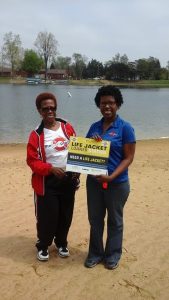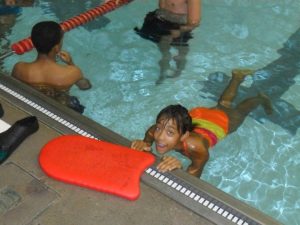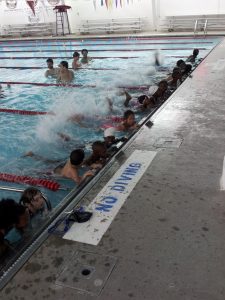
Wanda and Tankeeya Butts of The Josh Project pose at Olander Park where they installed a Life Jacket Loaner Station, thanks to a grant from the Sea Tow Foundation, after an 8-year-old boy drowned.
Tell me a little about your organization and how long have you been a Pool Safely campaign partner?
The Josh Project is a drowning prevention agency. Our mission is to build basic swimming skills and knowledge of water safety to prevent drowning. We’ve been a Pool Safely campaign partner since 2012.
What is the most useful/your favorite Pool Safely resource?
My favorite Pool Safely resource is the Water Watcher card. Nothing makes a parent more involved or aware in their child’s safety. Once I explain to parents what they’re for and how they’re used, it is almost as if I’ve sworn them in and deputized them into an official safety position. Week after week, I’ve had parents come to swimming lessons wearing their Water Watcher card. It makes me feel good to know that these parents take their job of supervision seriously.

A student smiles for the camera at a Josh Project swimming lesson.
What top 3 water safety steps or messages do you think are the most important for keeping kids safer in and around water?
The most important step to keeping kids safer around water is parental education. Parents should learn about water safety before leaving the hospital. Just as children can’t be driven home without a car seat, kids shouldn’t go home with parents that don’t know about the risks of drowning to their newborn. They should know that they are the first step to protecting their child from accidental drowning.

Three students pose with their certificates after learning how to Swim to Survive (R). They can roll into deep water, tread water for at least one minute and swim 25 yards.
The second most important step to keep kids safer around water is reinforcement of the drowning prevention education with parents. Parents hear “buckle up for safety” and “don’t text and drive” ALL the time, year-round. Water safety should be the same.
The third most important thing parents can do to prevent drowning is to make sure their children know the three skills needed to survive an unexpected fall into deep water. Every child should know how to roll, tread, swim and float on their backs. Start early and don’t stop until they meet this minimum standard for survival.
How has your organization made a difference among consumers when it comes to drowning prevention?

Students learn to swim at a Josh Project swimming lesson.
One of the ways that we’ve made a difference among consumers is that we’ve helped them understand that while swimming is fun, it is also a life skill that is useful for survival, as well as a means of employment.
Can you elaborate on The Josh Project’s efforts to break the cycle of fear that exists among some in the African American community when it comes to the water?
Yes, our overall efforts are aimed at addressing the fears of black parents and drowning. Many adults who had a bad experience with the water when they were young carry that fear for the rest of their lives. Fortunately, those fears have driven those same parents to enroll their children in swim lessons. From our post-lesson surveys, we’ve learned that the water safety practices that we recommend to the children and adults have helped increase their level of self-efficacy. Parents and children alike answered positively when we asked if they felt like they could be safe while in or around water. The result of one of our recent surveys found that providing children with free or reduced cost swim lessons, while providing their parents with supplemental water safety information at a convenient location is critical in getting participants to reenroll and ultimately prevent drowning.
The Josh Project was founded in 2007 by Wanda Butts in memory of her son, Josh, who drowned at a lake at the age of 16 in 2006. Josh was on a raft that capsized when his friends tried to get on it with him. Rather than allow his death to be just another tragic loss of life, Wanda has turned this tragedy into triumph by starting a water safety education program in Toledo, Ohio. In 2012, Wanda’s work with The Josh Project was recognized by CNN and she was named one of their “Top 10 Heroes” of the Year.

